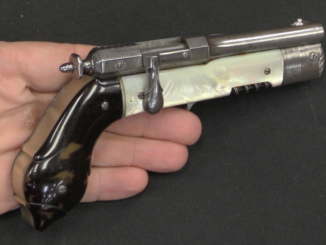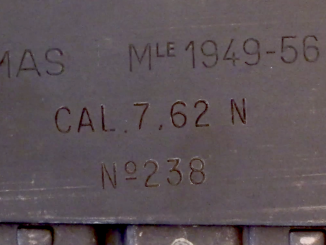The RSC 1917, aka FSA1917, has the distinction of being the only true semiautomatic service rifle to see significant frontline infantry use during World War One. It was introduced in 1917 as a long rifle, and about 75,000 were made in that configuration. An improved carbine model was developed in in 1918 right at the end of the war, with only a few thousand of those made. However, what we are looking at today are a pair of 1917 rifles which show a couple differences.
One of these is a standard RSC 1917 as originally produced, and the other has been updated to a 1918 standard in two ways: the bolt handle/disassembly and the bolt holdopen mechanism. I do not know if these changes were actually implemented during the war, or in the years afterward, but they make the rifles substantially easier to field strip.
If you know of details relevant to these changes, please let me know in the comments!




Would the rim of the 8mmm lebel also help in unscrewing the charging handle of the unmodified version or would you be forced to use a bullet tip or finger to do it?
Technically, there is one other difference. The 1916/17 RSC took a special 5-shot en bloc clip to load the magazine. The M1918 version was modified to use the same 5-shot en bloc clip as the Mannlicher-Berthier M1907/15-M16 bolt-action rifle. Which by mid-1917 had virtually replaced the Lebel tube-magazine bolt-action as the standard arm of frontline French infantry units. (It was somewhat less incompatible with Flanders mud than the Lebel was.)
cheers
eon
“(…)Mannlicher-Berthier M1907/15-M16 bolt-action rifle(…)”
Can you point to source which says that this rifle was co-designed by von Mannlicher?
I’m not sure where this has crept into common parlance.
The Smiths (small arms of the world, and the excrible book of Rifles) seem to be particularly fond of throwing such terms around.
It does seem to be selective and inconsistent, for example the Italian Modello 1891, gets referred to as a “Mannlicher Carcano”, and indeed the Italian state had taken a licence to work with Mannlicher’s EB bloc clip, and the prefix “Mannlicher” might help to distinguish the 1891 from Carcano’s needle fire design.
But transplant the magazine from an M 1891 onto anItalian Vetterli, and instead of “Vetterli Mannlicher” which would at least be consistent with “Vetterli Vitali”, it gets called a “Vetterli Carcano”.
One place you won’t see the Smith’s egregious belittling of guns as “merely a copy of” ___________ (insert “great man”), is with the likes of a Garand.
You won’t get him distinguishing between an M1 and a B59 or M14 by calling one a “Mannlicher Garand, and the others “Lee” Garands!
“I’m not sure where this has crept into common parlance.”
BTW: I will accept calling Berthier rifle Mannlicher-Berthier as soon as manual naming this weapon in this weapon will be showed to me.
https://www.forgottenweapons.com/lebel-and-berthier-manuals/
Here is manual for 1916 version which simply call this weapon FUSIL 1916.
Sadly I don’t know Français, so I can’t query WW1 manuals of main users of this weapon.
“Mannlicher-Berthier” and “Mannlicher-Carcano” are both clearly wrong historically, since apart from the en bloc clip neither had nothing to do with Mannlicher and neither was designated so in any official documents. Like Keith wrote, they seem to be invention of later American writers.
The Carcano M1891 does not even have the name Carcano associated with it in official Italian documents, but it is useful to differentiate it from the Mosin-Nagant M1891, and of course Salvatore Carcano was the lead designer. General Parravicino also had a major role, so even “Carcano-Parravicino” would be more correct than “Mannlicher-Carcano”, but strangely it does not seem to appear anywhere in literature.
In the book, HONOUR BOUND: The Chauchat Machine Rifle by Gerard Demaison and Yves Buffetaut, the authors state on page 91, the improved version of the RSA 1917 is called the M1918. “The M1918 did not appear until November, 1918; too late to see combat in WW1, although it was used by French forces in Morocco during the Rif War of 1921 – 1926, where it gave excellent results.” The 1917 and 1918 models are discussed on pages 88 to 91.